
-
Find the right food for your petTake this quiz to see which food may be the best for your furry friend.Find the right food for your petTake this quiz to see which food may be the best for your furry friend.Featured products
 Puppy Food
Puppy FoodHill's Science Plan Puppy Multipack Wet Dog Food with Chicken & Beef are complete premium pet foods for growing puppies from weaning until 1 year old and for pregnant and nursing dogs. Your puppy will love these deliciously smooth and savoury minced loaves, formulated for balanced nutrition and overall health.
Shop Now Adult Wet Dog Food with Beef
Adult Wet Dog Food with BeefHill's Science Plan Adult Multipack Wet Dog Food with Chicken, Beef & Turkey are complete premium pet foods for adult dogs from 1 year. Your dog will love these deliciously smooth and savoury minced loaves, formulated for balanced nutrition and overall health.
Shop Now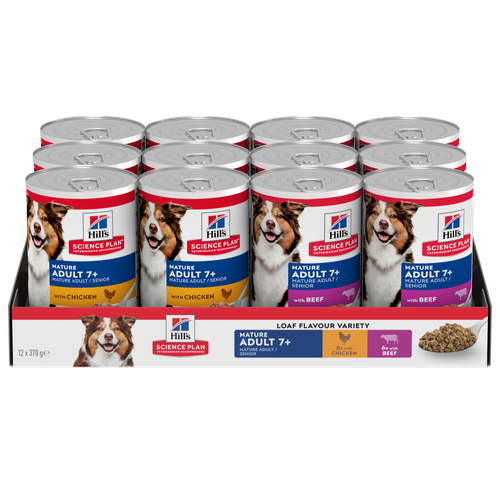 Mature Adult Dog Food
Mature Adult Dog FoodHill's Science Plan Mature Adult Multipack Wet Dog Food with Chicken & Beef are complete premium pet foods for mature adult dogs from 7 years. Your dog will love these deliciously smooth and savoury minced loaves, formulated to deliver the appropriate amount of energy to support the needs of adult dogs.
Shop NowFeatured products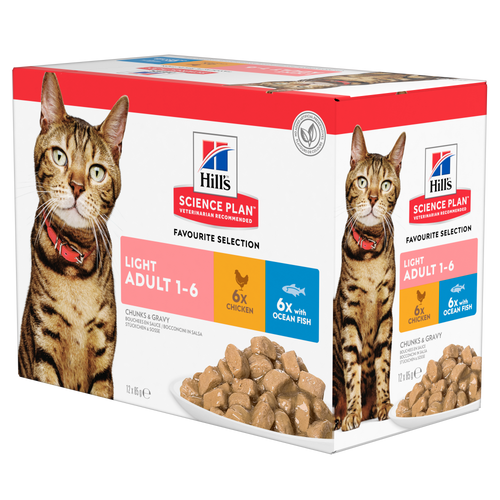 Light Adult Multipack Wet Cat Food with Chicken & Ocean Fish
Light Adult Multipack Wet Cat Food with Chicken & Ocean FishTender chicken chunks in gravy for cats, with L-carnitine and fewer calories for ideal weight management. Packed with high-quality protein, omega-6s, and vitamin E for shiny fur and healthy skin.
Shop Now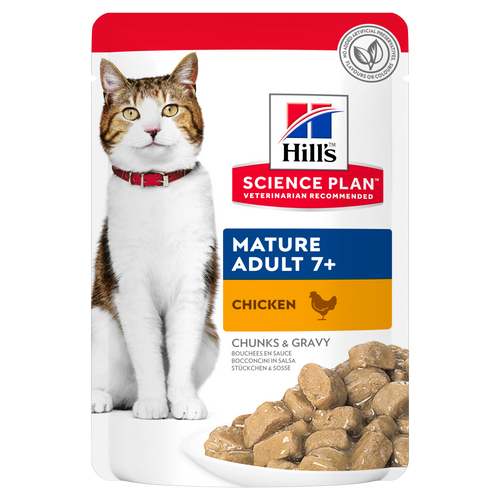 Mature Adult Wet Cat Food with Chicken
Mature Adult Wet Cat Food with Chicken
Tender chicken chunks in gravy for mature adult cats. Made with easy-to-digest ingredients, high-quality protein for lean muscle maintenance and antioxidant vitamins C+E for optimal health.
Shop Now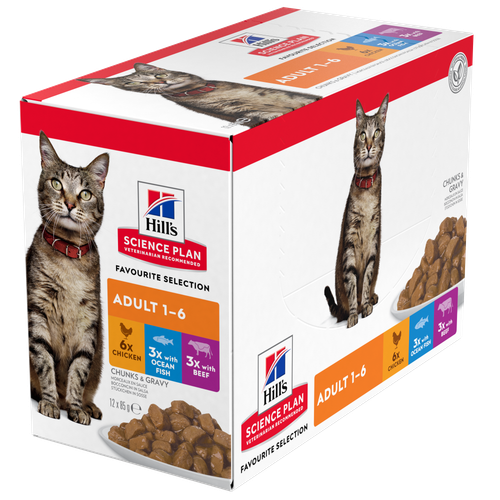 Adult Multipack Wet Cat Food with Beef, Ocean Fish & Chicken
Adult Multipack Wet Cat Food with Beef, Ocean Fish & ChickenTender chunks in gravy for cats, with high-quality protein to maintain lean muscle. With vitamin E and omega-3s & -6s for healthy skin and balanced minerals to support healthy vital organs.
Shop Now -
Dog
- Dog Tips & Articles
-
Health Category
- Weight
- Food & Environmental Sensitivities
- Urinary
- Digestive
- Joint
- Kidney
-
Life Stage
- Puppy Nutrition
- Adult Nutrition
- Senior Nutrition
Cat- Cat Tips & Articles
-
Health Category
- Weight
- Skin & Food Sensitivities
- Urinary
- Digestive
- Kidney
-
Life Stage
- Kitten Nutrition
- Adult Nutrition
Featured articles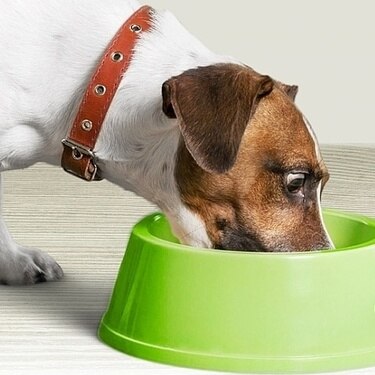 The Right Diet For Your Pet
The Right Diet For Your PetIn people, the right diet is very important. If you are eating the wrong way for your metabolism, activity level, age and lifestyle you could end up with health issues.
Read More The Incredible Science Behind Your Pet's Microbiome
The Incredible Science Behind Your Pet's MicrobiomeLearn what your pet's microbiome is, how it contributes to your pet's gut and overall health, and why nutrition is important in maintaining healthy microbiomes.
Read More Show some love with wet foods: a great choice for pets with health issues
Show some love with wet foods: a great choice for pets with health issuesShow some love with wet foods: a great choice for pets with health issues.
Read More -


Pancreatitis is a fairly common condition in dogs and is often associated with incidents like dogs raiding the bin and finding fatty leftovers like meaty remains. While pancreatitis can be a serious condition, if it’s caught early and treated, many dogs make a speedy and full recovery. Read on to learn more about what pancreatitis is, some of the signs that your dog may have it and what you can do if it does occur.
What is pancreatitis in dogs?
The pancreas is a flat, lobulated organ located in the front of the abdomen near the stomach. The pancreas has two main roles - producing insulin, and digestive enzymes. The cells that produce insulin are called the endocrine pancreas. Those that produce digestive enzymes are known as the exocrine pancreas. These digestive enzymes are released into the intestines to aid in the breakdown of food.
Because these enzymes are relatively indiscriminate in what they will break down, the pancreas has multiple safety mechanisms in place to try and ensure that these enzymes are not activated prematurely. Pancreatitis is a disease where these safety measures fail and the enzymes activate too soon, essentially digesting the pancreas and causing inflammation. Digestive enzymes may also eventually start leaking into the bloodstream, where they can be carried to other organs and cause damage. Most commonly though, the resulting inflamed pancreas shows itself through a number of different signs and symptoms, such as severe pain, vomiting, and a lack of appetite.
Stomach pain in dogs can show itself through excessive stretching, which looks much like a play bow with head bowed and a raised rear end. Pancreatitis can be a very serious disease, and the severity can range but may not always be life-threatening. However, it’s important to consult your vet if you suspect your dog is stretching due to stomach pain.
What causes canine pancreatitis?
In both people and animals, the exact triggers of pancreatitis are poorly understood. However, what is relatively well known is that whatever the inciting triggers may be, there is a common endpoint where digestive enzymes are released prematurely.
Most cases of pancreatitis in dogs are sudden and acute in nature, and generally have something to do with incidents where a dog has eaten a lot of fatty food all at once. With these cases, your veterinarian may be able to point to a single incident responsible for the havoc, such as excessive fatty scraps and gravy at a family gathering, or a dog that has raided the bin. Though signs may be slightly more subtle, chronic pancreatitis can also occur.



Tasty Tips
Clinical signs of pancreatitis in dogs
Dogs suspected of having pancreatitis may experience vomiting, lethargy and a painful abdomen, but clinical signs can be more vague. Pancreatitis can be mild or severe. Mildly affected dogs may experience dehydration, slight inactivity or an abnormal hunched posture (due to abdominal pain). Another classic sign of pain in the area of the pancreas is dogs adopting the play bow position for no reason. On the opposite end of the spectrum, severely affected dogs may have the following clinical signs:
- Elevated heart rate
- Decreased body temperature
- An enlarged, fluid-filled belly
- Yellowing of the eyes, skin and gums
- An abdominal mass
- Episodes of collapsing
Any dog can develop pancreatitis, and middle-aged to older dogs are at increased risk of developing the condition. Overweight dogs are also predisposed, along with dogs who are diagnosed with hypothyroidism, diabetes mellitus, Cushing's disease and hyperlipidemia, according to the Veterinary Information Network. Certain breeds, such as German Shepherds, are also more prone to developing chronic pancreatitis. This breed is also prone to another pancreatic issue called exocrine pancreatic insufficiency (EPI). This is where the pancreas doesn’t make enough digestive enzymes so the animals can’t digest food effectively. This means they tend to be thin and in poor condition, even though they eat ravenously. While EPI may arise on its own, it can also be caused by chronic pancreatitis due to damage to the cells, so the two often go hand in hand.
Miniature Schnauzers, Cocker spaniels, Yorkshire Terriers, Silky Terriers and Miniature Poodles may be at increased risk of acute pancreatitis. Both males and females may be affected. While any dog can develop pancreatitis, the best way to prevent a dog from developing this serious condition is to avoid feeding them fatty table scraps and treats.
Diagnosing pancreatitis in dogs
Reaching a diagnosis of pancreatitis can be quite complicated as the clinical signs are so vague. Your vet may recommend several types of blood tests and imaging, including:
- A full, general panel of blood tests to look for other diseases with similar signs
- A blood test to look for canine Pancreatic Lipase Immunoreactivity, or cPLI. This is an enzyme that is only produced in the pancreas. The inflammation of pancreatitis causes this enzyme to leak into the blood so it is usually a reliable diagnostic test.
- An abdominal ultrasound to look for an enlarged, swollen pancreas. If your vet does not have an ultrasound, they may refer your dog to a veterinary specialist for this examination. A few vets, usually at specialist centres, will perform a biopsy of the pancreas to get a definitive diagnosis. However, because biopsies are rarely undertaken in practice, the diagnosis of pancreatitis is often a presumptive one.

Treatment for pancreatitis in dogs
Dogs with acute pancreatitis usually require hospitalisation for fluid therapy, medications for pain and vomiting, and other supportive care. It's also essential to get these dogs eating as soon as possible once their condition is stable as this has been proven to speed up recovery. Because these dogs usually don't feel well and understandably may not have much of an appetite, your vet may recommend placement of a temporary feeding tube to ensure their caloric needs are being met until they've had more time to recover. While most dogs successfully recover from episodes of acute pancreatitis, this disease can be life-threatening and pets can deteriorate rapidly despite prompt, appropriate treatment. Pain medications are an important part of treatment because the condition is very painful... If your vet suspects pancreatitis, they may recommend transitioning your dog to a highly digestible, low-fat food to help prevent recurrent episodes or flare-ups.
Long-term outlook
The prognosis for dogs with pancreatitis is a challenge to predict. Most dogs will regain their health and pull through this disease, unless they are extremely ill when they arrive at the veterinary hospital. Even if your dog does require a lengthy hospital stay, this is not necessarily an indicator that they won't recover from this disease. The best outcomes are associated with prompt veterinary intervention, so if you catch clinical signs of pancreatitis in dogs, do not wait and see if they resolve on their own.
The prognosis for dogs with milder acute or chronic pancreatitis is generally better, particularly if a few lifestyle changes are made. Switching to foods low in protein and fat (since both are potent stimulators of pancreatic secretion), along with the addition of antioxidants and a program to support a healthy weight may all be recommended by your vet. However, it's important to understand that flare-ups may occur from time to time, even with a good response to your veterinarian's treatment plan. With a little patience and teamwork with your vet, as well as being able to recognise the early warning signs of a problem, you can give your dog a great chance at a relatively normal, healthy life.


Dr. Laci Schaible is a small animal veterinarian, veterinary journalist, and a thought leader in the industry. She received her Doctor of Veterinary Medicine from Texas A&M University and her Masters in Legal Studies from Wake Forest University.
Related products

Hill's Science Plan Adult Multipack Wet Dog Food with Chicken, Beef & Turkey are complete premium pet foods for adult dogs from 1 year. Your dog will love these deliciously smooth and savoury minced loaves, formulated for balanced nutrition and overall health.

Hill's Science Plan Puppy Multipack Wet Dog Food with Chicken & Beef are complete premium pet foods for growing puppies from weaning until 1 year old and for pregnant and nursing dogs. Your puppy will love these deliciously smooth and savoury minced loaves, formulated for balanced nutrition and overall health.
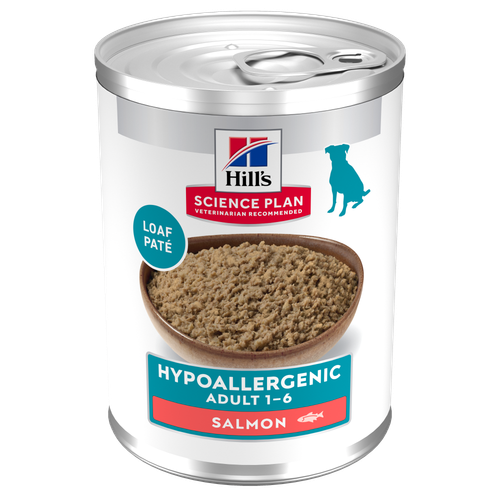
Hill's Science Plan Hypoallergenic Adult Wet Dog Food with Salmon is a complete premium pet food for all adult dogs from 1 year. This savoury tinned loaf is specially formulated for dogs with delicate skin and stomachs. It features a single novel animal protein source and is grain-free.

Hill's Science Plan Mature Adult Multipack Wet Dog Food with Chicken & Beef are complete premium pet foods for mature adult dogs from 7 years. Your dog will love these deliciously smooth and savoury minced loaves, formulated to deliver the appropriate amount of energy to support the needs of adult dogs.
Related articles

Learn effective tips for feeding a dog that's a picky eater and ensure proper nutrition for a finicky eater. Discover tips for pet parents at Hill's Pet UK.

Learn about the potential health risks of a raw diet for dogs and why they aren't the best option for your pup or you.

Many human foods are dangerous to dogs. Read about 5 of the worst toxic food offenders that can kill your dog - and how much it takes to hurt them.

How, when and what to feed your new puppy is an important decision, learn more about the things to consider for feeding your puppy.

Put your dog on a diet without them knowing
Our low calorie formula helps you control your dog's weight. It's packed with high-quality protein for building lean muscles, and made with purposeful ingredients for a flavourful, nutritious meal. Clinically proven antioxidants, Vitamin C+E, help promote a healthy immune system.
Put your dog on a diet without them knowing
Our low calorie formula helps you control your dog's weight. It's packed with high-quality protein for building lean muscles, and made with purposeful ingredients for a flavourful, nutritious meal. Clinically proven antioxidants, Vitamin C+E, help promote a healthy immune system.

